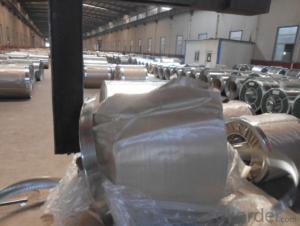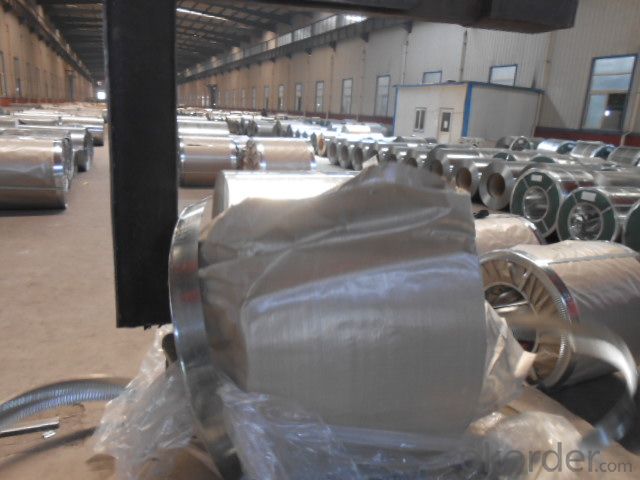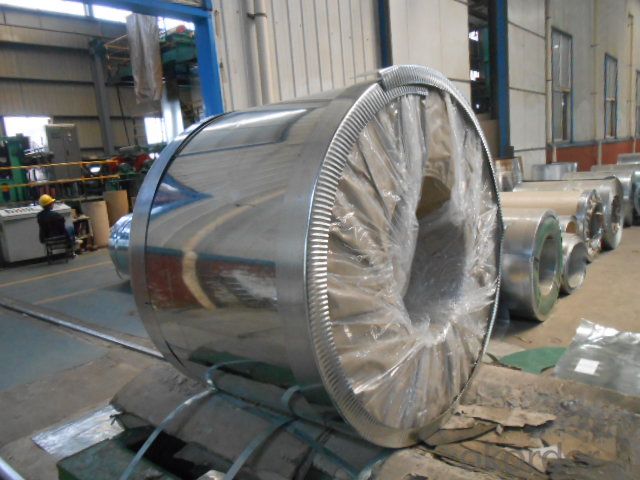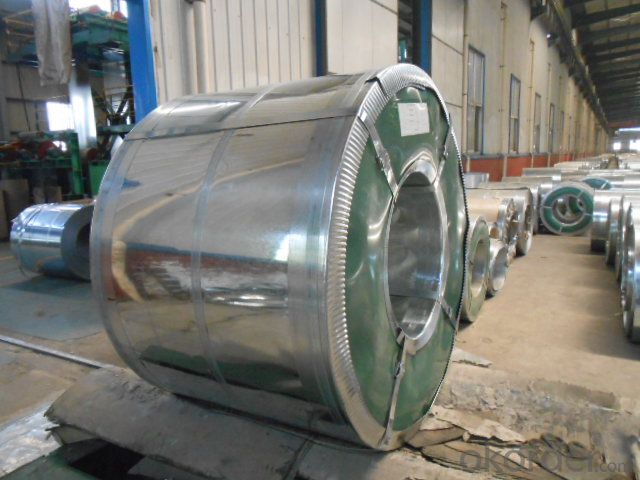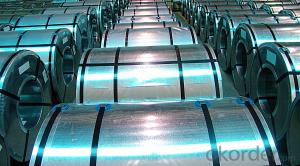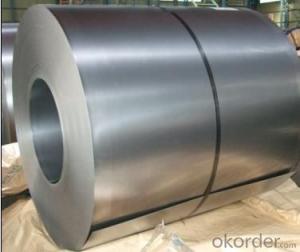HOT DIPPED GALVANIZED STEEL COIL BEST
- Loading Port:
- China Main Port
- Payment Terms:
- TT OR LC
- Min Order Qty:
- -
- Supply Capability:
- 10000 m.t./month
OKorder Service Pledge
OKorder Financial Service
You Might Also Like
HOT-DIP GALVANIZED STEEL COIL
SIZE:0.2mm*762mm*C
ZINC COATING:60g/m2
STANDARD:JIS G 3302
SURFACE:CHROMATED,REGULAR SPANGLE, UNOILED
STEEL GRADE:SGCH HARD QUALITY(75-95 HRB)
COIL WEIGHT:3-6 ton
COIL ID:508mm
TOLERANCE: THICKNESS:-0.02mm; WIDTH:0/5mm.ZINC COATING:60g/m2 TOLERANCE:+/-10% WITH QUANTITIES AND AMOUNT.
PACKAGE:FULL PACKED WITH ANTI-DAMP PAPER,IRON SHEET OUTSIDE;
PRODUCTION TIME:30DAYS AFTER RECIEVE DOWN PAYMENT OR CORRECT LC.
PAYMENT TERM:20%TT,80% AGAINST BL COPY./100% IRREVOCABLE LC AT SIGHT.
- Q: Which is more reactive? Zinc or Steel? And why?
- Zinc. Steel is an alloy consisting mostly out of iron, In the reactivity seris, zinc is more reactive than iron. Therefore, zinc is more reactive than steel
- Q: How are steel coils used in various industries?
- Steel coils are used in various industries for a wide range of applications. In the automotive industry, they are used to manufacture car bodies, chassis, and parts. In construction, steel coils are used in the production of beams, columns, and roofing materials. They are also utilized in the manufacturing of appliances, electrical equipment, and machinery. Additionally, steel coils are essential in the production of pipes, tubes, and other structural components. Overall, steel coils play a crucial role in providing strength, durability, and versatility to multiple industries.
- Q: like building steel beams. i'm pretty sure with a sawzall.
- I am going to take a slightly different approach. Once the structural steel is manufactured and then brought to the fabricator, not much heat is applied to the steel. It is normally punched, sheared or whatever buy the use of a lot of heat on it is normally not allowed due to the change in the properties of the steel. Once in the field to be erected, the cutting or welding on it are held to absolute minimums and most of the time not allowed at all.
- Q: What are the different methods of embossing steel coils?
- There are several different methods of embossing steel coils, each with its unique characteristics and applications. Some of the most common methods include: 1. Hot embossing: This method involves heating the steel coil to a high temperature and then pressing it between two engraved rollers. The heat softens the steel, making it easier to imprint the desired pattern onto the surface. Hot embossing is often used to create intricate designs or textures on steel coils. 2. Cold embossing: In contrast to hot embossing, cold embossing does not involve heating the steel coil. Instead, it uses pressure and specially designed dies or stamps to create the desired pattern on the surface. Cold embossing is commonly used for simpler designs or when heat-sensitive materials are involved. 3. Roller embossing: Roller embossing is a method that utilizes a series of rollers with engraved patterns to imprint the design onto the steel coil. The steel coil is passed through the rollers, and the pressure applied causes the pattern to be transferred onto the surface. This method is often used for larger-scale production and can achieve consistent and uniform results. 4. Laser embossing: Laser embossing is a modern method that utilizes laser technology to create patterns on steel coils. The laser beam is directed onto the surface, selectively melting or vaporizing the metal to create the desired design. This method offers high precision and flexibility, making it suitable for intricate and detailed patterns. 5. Press embossing: Press embossing involves the use of a press machine equipped with custom-made dies to imprint the desired pattern onto the steel coil. The coil is placed between the dies, and the press machine applies pressure to transfer the pattern onto the surface. This method is commonly used for large-scale production and can achieve high-speed and high-volume embossing. Overall, the choice of embossing method depends on various factors such as the desired design complexity, production volume, material properties, and cost considerations. Each method has its advantages and limitations, and manufacturers must carefully select the most suitable method for their specific requirements.
- Q: how many persent of manganese in all types of carbon steel
- i think it is 1.65%...
- Q: I got a muzzy carp point arrow and its head is steel with 1.7% carbon, its used in the water. Will i have to dry it after every use or is it stainless. Thanks
- carbon will rust.. stainless doesn't rust unless it touches carbon so its definitely not stainless. Since its only 1.7% its extremely unlikely that it will rust unless you leave it outside for extreme long periods of time. Either way you should take care of it. Put it in the garage or something but you don't have to dry it after every use.
- Q: How are steel coils used in the production of automotive engine components?
- Steel coils are used in the production of automotive engine components by being processed and shaped into various parts, such as pistons, crankshafts, and connecting rods. The coils are first cut, stamped, and formed into the desired shapes, and then undergo heat treatment and other machining processes to enhance their strength and durability. These components are crucial for the proper functioning of an automotive engine, as they provide structural support and help convert the energy generated by the combustion process into mechanical motion.
- Q: I saw this really pretty ring online and it was made of steel. Is this a good ring? If I were to wash my hands with it on, would it rust and turn my finger green?
- Steel rust is brown not green! Very much expected to be of one type of stainless steel, and you should have no problem.
- Q: Why is the steel tape tape head not fixed?
- It makes sense to be irregular;You can see the standard ruler of steel roll head is a gap, when you take the time to object quantity, the head will indent the gap, so you measure is the size of the head from the head of steel;When you hook the object, the head will pull apart and you'll take the dimension from the end of the steel head.
- Q: i am working a client.my vendor specified in pipe specification pipe line class as MS1 (code for Mild steel)but assigned material to this code is cs smls astm A 106B.my question is any difference between CS and MS material?pls suggest me
- *Carbon steel, also called plain carbon steel or Mild Steel, is steel where the main alloying constituent is carbon. The AISI defines carbon steel as: Steel is considered to be carbon steel when no minimum content is specified or required for chromium, cobalt, columbium, molybdenum, nickel, titanium, tungsten, vanadium or zirconium, or any other element to be added to obtain a desired alloying effect; when the specified minimum for copper does not exceed 0.40 percent; or when the maximum content specified for any of the following elements does not exceed the percentages noted: manganese 1.65, silicon 0.60, copper 0.60. If it crosses limit as said, it will come under alloy steel. ASTM A 106 gr B is a carbon steel pipe and seamless Pipe for High Temperature Service. So, it will be a mild steel comes under carbon steel category.
Send your message to us
HOT DIPPED GALVANIZED STEEL COIL BEST
- Loading Port:
- China Main Port
- Payment Terms:
- TT OR LC
- Min Order Qty:
- -
- Supply Capability:
- 10000 m.t./month
OKorder Service Pledge
OKorder Financial Service
Similar products
Hot products
Hot Searches
Related keywords
